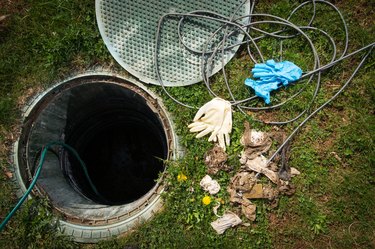
Septic tanks allow people to flush their wastewater without being connected to a citywide sewer system. Two tanks hold the majority of the wastewater at any given time. They separate the solid waste from the water itself through a natural settling process. The leftover water, known as effluent, is then dispersed into a drain field via long, horizontal and perforated pipes called lateral lines.
The Importance of Lateral Lines in a Septic System
The lateral lines in a septic system allow the effluent water to trickle into an area designed specifically to filter and clean the water before it re-enters the groundwater. When the lateral lines, also known as field lines or leach lines, work properly, the septic tank itself shouldn't experience any problems with water outflow. However, sludge and paper products that normally remain in the tanks can occasionally enter the lateral lines and cause problems with drainage. Aggressive tree roots can also sometimes enter the pipes via the perforations.
Video of the Day
Cleaning Septic Tank Lateral Lines
Septic systems can be accessed by homeowners or technicians via holes at ground level. The lateral lines connect to the sludge tanks through a distribution box. Inside the box, you'll find a single input pipe on one side and several pipes — at least three, typically — branching off the other side or sides. These are the lateral lines.
Video of the Day
Here are three tools to flush these pipes:
- Plumber's snake: This device has a corkscrew on the end to bore through clumps. You can crank plumber's snakes by hand or connected to a power drill for extra oomph. Snakes can be effective for clogged septic tank field lines caused by paper products and sludge, but it won't pull the entire clog out. The snake will open and loosen the clog so that when you flush the line later, the materials move down the pipe.
- Water jet: This flexible hose is inserted into each of the septic tank laterals and high water pressure blasts through clogged debris. Moving the hose further along the line will simultaneously unclog and clean it.
- Chemical cleaning products: You can use these, but know that chemical cleaning products do not always clean drains well. Septic tank treatment solutions tend to work best when the pipes only have minor sludge buildup, not large blockages that cause problems with effluent flow into the drain field. Take care when choosing chemical additives because they may cause environmental contamination and affect groundwater quality.
Septic System Cleaning Limitations
A major complication when it comes to cleaning clogged septic tank field lines is tree roots that have invaded the pipe. The roots follow the path of least resistance when looking for space to grow, and this makes the perforations and hollow interiors of the pipes prime real estate.
A water jet may have enough power to break off thinner roots, but the roots will likely come back. Thicker roots are no match for plumber's snakes or water jets and may require a more significant intervention, such as digging up the roots at the source. Chemical additives can be helpful in killing the roots and preventing them from returning.
However, prevention and ongoing maintenance are key when it comes to roots and septic lateral line cleaning. It also helps to have the drain field properly prepared in the first place. Starting with roots in the soil and trees too close to the field is simply asking for trouble. Avoid having to do a drain field cleanout by taking precautions during installation and maintaining both the sludge tanks and the septic tank lateral lines regularly.